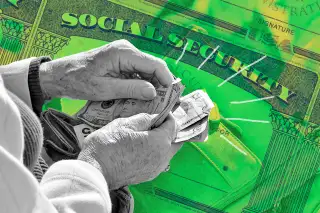Why Some Social Security Recipients May Get Smaller Checks Starting in August

If you got a letter from Social Security this spring claiming you were overpaid, don’t ignore it: Your benefits could be slashed in the coming weeks.
Social Security overpayments happen when the government sends more money than someone is eligible to receive — often due to changes in income, marital status or disability status that weren’t reported in time to update records. Sometimes, the mistake is on the agency’s end — a clerical error or miscalculation. Either way, the Social Security Administration is legally required to try to recover, or “claw back," some of the funds, even if the recipient had no idea they were being overpaid. The government does this by withholding benefits.
In practice, though, the rules around clawing back funds have shifted in recent years. Under the Biden administration, the default withholding rate was reduced from 100% to 10% to ease financial strain on recipients. At the start of the Trump presidency, the administration briefly switched the policy to recover 100% of overpayments before settling on the current rule: a 50% clawback rate.
That means if you received an overpayment over the past several years, the government can withhold up to 50% of your future monthly benefits until it has recovered the full amount of the overpayment.
The Social Security Administration began issuing overpayment notices with the new rule on April 25, warning that recipients who didn't respond within 90 days could see half of their monthly benefits automatically withheld. While that 90-day window ends on July 24, most beneficiaries won't see a change in their payments right away.
Each overpayment notice includes its own designated start date for withholding, meaning some beneficiaries may see reductions as soon as August, while others might not be affected until later, says Jim Blair, founder of the National Social Security Advisors (NSSA).
In other words, timing varies — and it depends on several factors.
"The key nuance here is that the SSA does not uniformly reduce benefits on day 91," says Michael Liner, founder and head disability attorney at Liner Legal. "The timing of when the benefit reduction takes effect can depend on the beneficiary’s payment schedule and when the SSA processes the reduction on their end."
While July 24 may be the technical deadline, Liner explains, the actual reduction might not show up until the August benefit payment, which — depending on the recipient's birthdate — could fall anywhere between August 2 and August 23.
Between 2015 and 2022, the SSA made nearly $72 billion in improper payments. That's less than 1% of the total benefits paid during that time, but still a major burden for those now being asked to repay. As of late 2023, $23 billion remained outstanding, according to a report from the Office of the Inspector General.
What to do if you receive an overpayment notice
If you’ve received an overpayment notice, you have a few options — but acting quickly is key, according to Travis Stanley, president of NSSA.
If you believe the overpayment notice is incorrect, you can file a Request for Reconsideration form to appeal the decision. Alternatively, you can request a waiver, which asks the SSA to forgive the debt entirely if you can show that the overpayment wasn't your fault and that repayment would cause financial hardship. This typically involves providing information about your financial situation, including current income and expenses.
Both the reconsideration and waiver forms must be faxed, mailed or dropped off at your local Social Security office. They cannot be submitted online.
"There are multiple avenues available — including waivers, appeals, and negotiated repayment plans — and engaging early can help avoid unexpected reductions and preserve flexibility in how the situation is resolved," says Stanley.
If you don't need to dispute the overpayment request but the repayment amount is too high, you can ask the SSA to lower the withholding amount by submitting a Request for Change in Overpayment Recovery Rate form. This form must also be faxed, mailed or dropped off at your local Social Security office.
If no action is taken, the SSA will typically begin withholding benefits after the date listed in the notice — often the next scheduled payment following the end of the 90-day window.
CORRECTION: A previous version of this article misidentified a speaker. The quote was incorrectly attributed to Jason Stanley, vice president of strategy at NSSA. It should have been attributed to Travis Stanley, president of NSSA.
More from Money:
The Trump Administration Is Clawing Back Social Security Overpayments. Here's What to Know
When Social Security Recipients Will Get Their Checks in July
Social Security's Trust Funds Will Run Out of Money in Less Than 10 Years